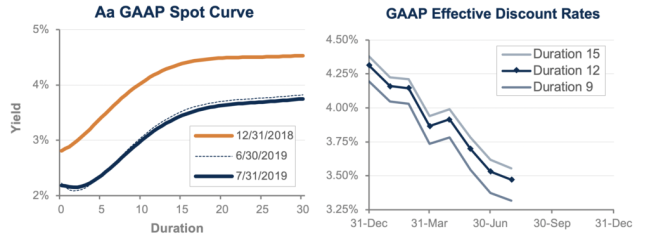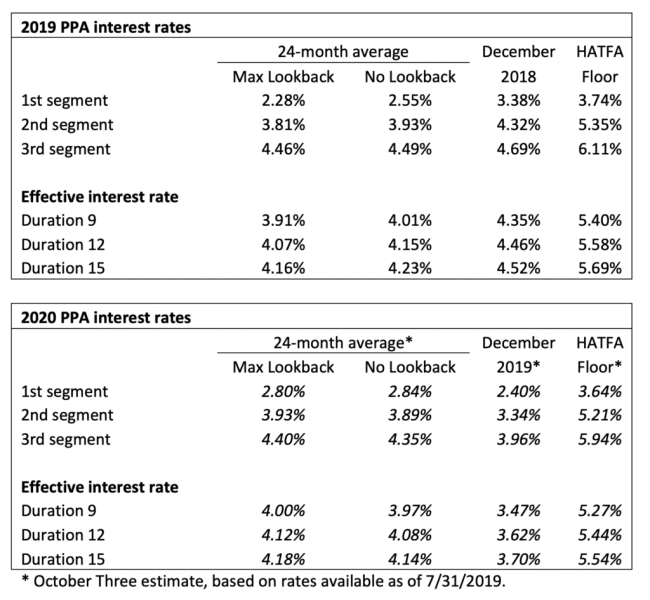July 2019 Pension Finance Update
Pension finances dipped slightly in July as long-term corporate bond yields hit record lows. Both model plans we track[1] lost a fraction of 1% last month and are basically treading water (Plan A down 1%, Plan B flat) through the first seven months of 2019:

Assets
US stocks, led by NASDAQ, enjoyed another strong month in July, in what is turning into a very strong year, while overseas stocks, particularly emerging markets, lost ground last month and have significantly trailed US markets so far in 2019:

Treasury bonds were flat in July as yields crept up a couple basis points, while corporate bond yields earned almost 1% as yields fell a few basis points. Through July, bonds have earned 8%-11%, with long duration and corporate bonds performing best.
Overall, our traditional 60/40 portfolio gained less than 1% in July and is now up 13% so far this year, while the conservative 20/80 portfolio also gained less than 1% last month and is up 11% during 2019.
Liabilities
Pension liabilities (for funding, accounting, and de-risking purposes) are driven by market interest rates. The graph on the left compares our Aa GAAP spot yield curve at December 31, 2018, and July 31, 2019, and it also shows the movement in the curve last month. The graph on the right shows our estimate of movements in effective GAAP discount rates for pension obligations of various duration during 2019:

Corporate bond yields inched down a few basis points last month. Credit spreads have narrowed more than 0.3% this year, and long-term corporate yields are now at all-time lows. Pension liabilities increased 1% in July and are now up 11%-16% for the year, with long duration plans seeing the largest increases.
Summary
So far in 2019, stock markets have given, and falling interest rates have taken away, leaving pension finance treading water. The graphs below show the progress of assets and liabilities for our two model plans through the first seven months of 2019:

Looking Ahead
Pension funding relief has reduced required plan funding since 2012, but under current law, this relief will gradually sunset by 2023, increasing funding requirements for pension sponsors that have only made required contributions.
Discount rates fell a few basis points last month and have now reached the lowest yields on record. We expect most pension sponsors will use effective discount rates in the 3.2%-3.7% range to measure pension liabilities right now.
The table below summarizes rates that plan sponsors are required to use for IRS funding purposes for 2019, along with estimates for 2020. Pre-relief, both 24-month averages and December ‘spot’ rates, which are still required for some calculations, such as PBGC premiums, are also included.

[1]Plan A is a traditional plan (duration 12 at 5.5%) with a 60/40 asset allocation, while Plan B is a largely retired plan (duration 9 at 5.5%) with a 20/80 allocation with a greater emphasis on corporate and long-duration bonds. We assume overhead expenses of 1% of plan assets per year, and we assume the plans are 100% funded at the beginning of the year and ignore benefit accruals, contributions, and benefit payments in order to isolate the financial performance of plan assets versus liabilities.
